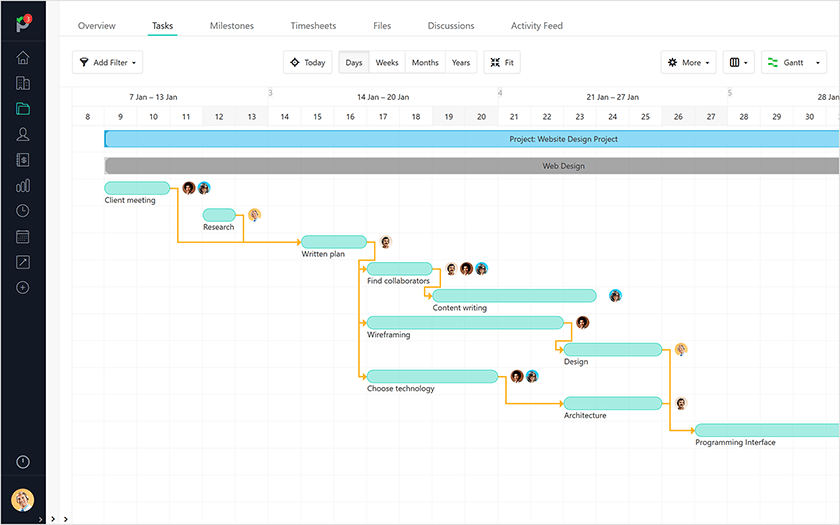What do all successful people have in common? They ask questions. The same goes for project managers who deliver outstanding projects consistently.
This skill is crucial, given the complexity each project can take.
Why?
Because you’ll be able to identify your most significant issues and poke holes through them even before you develop a project management plan, not to mention the extra level of readiness provided by a set of available answers in case unexpected changes occur. Oh, and they will, trust me.
Note: if you’ve just started out in the field of project management or would like to explore this career path or a job opening in your company, read our guide on how to be a project manager. If you’re looking for a comparison of pm methods and planning, check out these examples of project management methodologies.
So before the start of your next project, have it in check by asking these seven essential project management questions:
1. What is the project’s objective?
Why this is important:
For the correct development of your project management strategy, have all objectives in mind from the start. Get your client’s primary requirements and objectives for the project to better plan the project development process and direct your team’s activities toward the main goals.
With no clue about the project deliverables, chaos will soon emerge within your team and blur the lines regarding who should be in charge of what.
How to handle this:
As part of a complete client management process, get together with your client to set the project’s objectives based on their needs, available resources, and time constraints. Debate until you arrive at the set objectives agreed upon by both sides and put them down, so you have a visual representation.
Aim to set measurable objectives from the beginning so you can meet all client requirements without further revisions. Set SMART (Specific, Measurable, Achievable, Relevant, Time-bound) objectives that allow you to precisely see what, how, and when to achieve them. When planning your project (particularly during the task management process), you must dedicate at least one activity to each objective to ensure you’re on the right track and gaining momentum.
2. When is the deadline?
Why this is important:
A set deadline shows you just how much time you’ve got to conduct the entire project. The project’s deadline, milestones, and other time constraints tell you how to distribute your work, what activities you’ve got enough time for, and how many schedule time buffers you can add for possible delays and fixing issues.
How to handle this:
One of the best tools you can use to map out your timeline and see your deadlines in a single place is the Gantt Chart. This technique helps you identify task dependencies, deadlines, and more. You can use it to plan activities in advance, get a full view of your milestones, establish your project’s critical path, and see which team member is working on a particular task at a specific moment in time.

Gantt Chart example in Paymo
Create your first Gantt Chart with a free Paymo trial.
Note: You can also opt-in for another interactive Gantt chart builder for charting the project timeline.
For team management, you can also use resource scheduling to see which resources are overallocated or not and their availability during a given time period. This tool lets you manage task execution and the team members responsible for each activity based on their workloads.

Resource Scheduler used in Paymo
For a detailed look at how you can create a resource plan and schedule your team in Paymo, check out our guide.
Don’t forget about deadlines. Set a start and end date for every single activity. These will ensure that everything is under control so you can take action when a task is overdue and work on others that depend on the previous ones. Team members will no longer have to wait for another teammate to finish a task because everyone’s schedule will be planned from top to bottom.
3. Have you had a similar project before?
Why this is important:
Having worked on a project with similar traits in the past can offer valuable knowledge for the next one. By now, you should be able to tell what worked and what didn’t from your past knowledge. You can use similar resources, budgets, time estimates, activity lists, and people. The latter will bring their recommendations based on their previous experience on similar tasks so that the same mistakes are not repeated. You can make a similar analysis and set project estimates, meaning you’ll have a clearer picture of your project profitability.
How to handle this:
Completed projects provide relevant insights and help you prepare for risks or issues you wouldn’t have thought of in the first place. Pull them out of your archive and have a better look at them.
Or turn to your client. You might not have dealt with a project like the current one in the past, but your client is likely to have come across this. In this case, their judgment and understanding will prove highly valuable when deciding on a deadline and establishing a budget.
Got a project that’s strikingly just like the one you’ve had before but for another client? Lucky you. If you’re using project management software, you can clone the past project and make adjustments so that it fits any minor differences.
4. How will the team communicate?
Why this is important:
Effective communication is vital within any team if you want your project to be completed on time with fewer mistakes. The team members should be able to communicate throughout the whole project. Hence, they know exactly what’s going on during each stage, what they’re in charge of, who they should talk to in case of a question, and be immediately informed when a change happens.
How to handle this:
Email is no longer a good enough choice when dealing with projects requiring constant feedback exchange. Tools like Slack, Google Hangouts, or Skype are used for team collaboration and can be paired with a project management tool. The latter allows you to distribute tasks, allocate resources, manage the project’s execution, and ensure that everything stays within scope, deadline, and budget. You can even collaborate on each task through comments and file sharing, regardless of whether your team members work on-site or remotely.
Don’t forget to always communicate with your client to ensure you’ve received feedback on time. Establish your primary method of contact from the beginning, whether this is your usual exchange of emails or a client access platform supported by your project management tool of choice. The client’s approval for the work you’ve done so far, timelines, and budget allocation are some prerequisites for the project to move forward and successfully reach its deadline.
5. What tools will be used?
Why this is important:
Projects can be complex. Work on a project can’t be done effectively and within the deadline without using any digital tool. With so many activities, people, resources, and costs to handle simultaneously, you’ll have to get the help of a few digital tools. You’ll need the occasional event reminder from your digital calendar or video calling tool to stay connected with your client or remote workers.
How to handle this:
Besides the collaboration tools mentioned above, there are more tools you should consider if you’d like a bit more help with other duties. A project management tool, for instance, does more than just support collaboration. It can help you plan and manage tasks, distribute resources, handle risks, organize project portfolios, and much more.
These can be paired with time-tracking tools to measure how much time each employee spends on a task, create timesheets, and use time reports to make better time estimates for future projects. You can also consider other tools such as code editors, prototyping, image editing, marketing, file storage, or organization tools.
What users love most is that you can take it a step further, making use of estimates, expenses, and invoicing, to easily receive payments based on those timesheets (time worked). Here are the best electronic invoicing software—that far outweigh pen-and-paper ledgers—if you’re a business owner or team leader in charge of a big project. If you’re a freelancer, consider going for a free invoice generator online.
6. What are the project’s priorities?
Why this is important:
When you have multiple projects to handle simultaneously, task management is only done right when you’ve correctly prioritized your tasks. Establishing the proper completion order helps your team stay organized and meet the project’s goals on time.
How to handle this:
First, you need to know these two types of priorities you can set when you’re sorting through tasks:
- Time-based (this week/ month/his year/today/tomorrow/late/upcoming): A time-based priority implies you must complete the task before the end date you’ve decided upon. For example, a web development project due in two weeks or a prototype must be sent by Friday.
- Urgency-based (Critical, High, Medium, or Low): These tasks must be completed for the project to reach one of its goals. The order in which you handle them depends primarily on when they’ll influence the project’s outcome. For example, if your app’s login form doesn’t work suddenly, you need to offer immediate attention and fix the problem quickly.
You can apply many easy task prioritization tips and methods for your task lists, like the Pareto Principle. Also known as the 80/20 rule, it states that barely 20% of the activities that are part of a project count for 80% of the end results. Your job is to identify those activities and ensure you deliver them on time, without compromise.

7. What are the risks?
Why this is important:
Risks are events, situations, actions, or factors that can affect a project’s development, objectives, outcomes, resources, schedule, and budget. Any project will face a risk or change at some point.
Identifying risks before they happen helps you prepare a plan for preventing them from happening. It will help you handle those that can’t be controlled, such as a natural disaster affecting the construction of a building or your web developers catching the flu just a couple of weeks before the website’s launch.
How to handle this:
As a project manager, you’re in charge of assessing what risks can happen in the future and when they’ll occur and handling them so that it doesn’t affect the project’s outcomes. Put together your risk breakdown structure (RBS) before you start planning to have all potential risks in order before you start work.
Keep in mind that risk management is a continuous activity done during the whole project development process. Create a risk register to keep track of a risk’s evolution and mark updates on its status and effects. Just make sure you don’t miss any of them.
Remember, these are just 7 of the first project management questions you should ask yourself before you develop a plan and start working. An actual project is much more complex. You’ll also need to think about solving team and stakeholder disagreements, what methods and workflows you’ll use, how performance will be measured, and so much more.
Understanding these details before you get to work is essential to ensure smooth project execution and delivery. Put down every important aspect that goes through your mind, get your team and client’s feedback, and address all issues before you plan the project.
Found this article helpful? Please spread the knowledge and share it with your teammates and followers.
First published on November 29, 2019.

Alexandra Cote
Author
Alexandra Cote is a SaaS content writer and strategist with a passion for workplace productivity, social media marketing wonders, conversion rate optimization, artificial intelligence, and keyword research. Reach out to her via LinkedIn.



